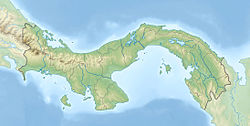| Caraba Formation | |
|---|---|
| Stratigraphic range: Early Oligocene | |
| Type | Formation |
| Underlies | Las Cascadas & Caimito Formations |
| Overlies | Bas Obispo, Bohío & Panama Formations |
| Lithology | |
| Primary | Sandstone |
| Other | Conglomerate |
| Location | |
| Coordinates | 9°06′N79°42′W / 9.1°N 79.7°W |
| Approximate paleocoordinates | 7°06′N77°30′W / 7.1°N 77.5°W |
| Region | Panamá Province |
| Country | Panama |
| Extent | Panama Basin |
| Type section | |
| Named by | Jones |
| Year defined | 1950 |
The Caraba Formation (Tcr) [1] is a geologic formation in Panama. The formation was first defined in 1950 by Jones as a facies member of the Caimito Formation. [2] The formation consists of poorly lithified, pebbly, tuffaceous, calcareous sandstones and conglomerates and preserves fossils dating back to the Early Oligocene period. [3]
